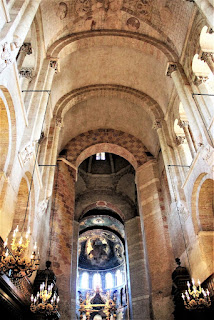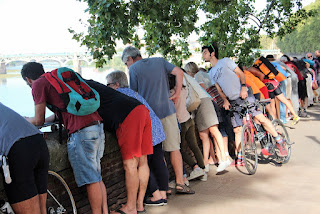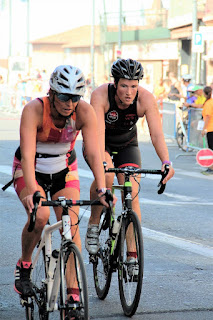Catholic Pilgrimage to Lourdes, France in 2016 - Part 2/2
Part C : A day trip to Torresciudad
From Lourdes we chartered a small bus and made a day-trip to pay homage to Our Lady of Torreciudad at the sanctuary located in Spain. About 220 km away. The journey lasted over 3+ hours each way, crossing the mountains of Pyrenees dividing France and Spain. Shown scenes of the Pyrenees.
Sanctuary of Torreciudad
The Sanctuary of Torreciudad is a shrine in the region of Aragon in Spain to honour Our Lady of Torreciudad, a title given to the Blessed Virgin Mary, mother of Jesus.
Old shrine
At a rocky spot some 24 km from the town of Barbastros in Aragon, there existed an old shrine housing a wooden statue of the Black Madonna since the 11th century. The statue bears the name of Our Lady of Torresiudad. Shown the old shrine which is a low tower, and the harsh neighbourhood.
Josemaria Escrivá and the new Sanctuary
Josemaria Escrivá de Balaguer was born in 1902 at the town of Barbastros. He was seriously ill when he was 2 and was not expected to survive. He was brought by his parents to the old shrine to pray. He did survive, went on to be ordained as a priest and later founded the Catholic institution of Opus Dei. He died in 1975 and was canonised in 2002.
The new Sanctuary of Torreciudad was initiated by Josemaria Escriva in the 1970s. It was consecrated on 7th July 1975.
The new Sanctuary
Shown the main church and the huge esplanade. The sanctuary has great retreat facilities. There is an altar on the external wall of the main church meant to be used for outdoor mass. On this altar is a new bronze statue of Our Lady of Torreciudad, larger than the original which is now set in the sculptured altarpiece in the church.
Columns of the entrance porch and the Holy Door of Mercy. The 3rd photo shows some wall decoration and the last photo shows the ribbon boards for pilgrims to write their petitions. The board of ribbons has this caption: "Leave to Our Lady the knots of your life. She unties them all."

The interior
The great altarpiece is 14.5 m high and 9.5 m wide, 1st photo. Huge! Set in the altarpiece is the original Romanesque carved statue of Our Lady of Torreciudad. On the altarpiece are eight sculptured groups in alabaster representing some of the main events in the life of Our Lady. One of the groups is “Crucifixion of the Lord” shown in the 2nd photo.
The Crypt
There are 3 chapels in the crypt. Shown those of Our Lady of Loreto and Our Lady of the Pillar. There are more than 40 confessionals in the crypt.
Statue Gallery
One unique feature of this Sanctuary is the Statue Gallery with a collection of over 200 statues of the Blessed Virgin Mary from all over the World, each attired in the unique way. Shown a few of them. Unfortunately the explanatory notes are in Spanish only so no explanation of their origins.
Stations of the Cross
The 14 Stations of the Cross are located on a track overlooking the old shrine. The images are made with ceramic titles. Shown the last 2 stations, the only 2 visited by us.
The Rosary
Saying the Rosary and contemplating the Mysteries of the Rosary is very much encouraged here. The scenes of the mysteries are depicted in ceramic tiles. Shown two of them.
Part D : 3 nights in Toulouse
Toulouse is our gateway to/from Lourdes, about 175 km apart. It is the 4th largest city in France, with a city population of about 450,000. Toulouse is the centre of European aerospace industry. Airbus has its HQ here, as well as assembly lines of several Airbus models. It also has other enterprises involved in satellites and space programs.
We roamed around the city on our own for 2 full days. Since this is a pilgrimage trip, we visited more churches.
Toulouse Cathedral (Cathedral St Etienne)
The cathedral, seat of the Archbishop of Toulouse, was built and part rebuilt over the years. Very confusing layout with contradicting architecture styles because it was the product of combining 2 half-completed churches. The oldest chapel is dated to the early 1200s. The tower is dated to the 16th century. Shown the west façade and the high altar completed in 1668. There are many chapels and most of them have large and tall panels of stained-glass windows as the background. Shown 2 of these windows.
We attended an evening mass at the St Anne Chapel, a separate building next to the Cathedral.
Basilica St Sernin
St Sernin is the 1st bishop of Toulouse, martyred around the year 257. Most part of the church was built around 1080 to 1120. It is the biggest remaining Romanesque building in Europe, if not in the World. In 1998 the basilica was added to the UNESCO World Heritage Sites grouped under "Pilgrimage Route of Santiago de Compostela in France".
This is a massive church as shown in the 1st photo, with the western entrance to the right. The 2nd photo shows the view on the eastern side. The 5-tier bell tower, 3rd photo, is a clear demonstration of the Romanesque design. KC/YL and family is on the southern side.
Shown a shot of the narrow nave, 1st photo. The main treasure of the church is held in the crypt where a small entrance fee is collected. The notable reliquaries include that of St Sernin and other local saints, mostly kept in gilded cabinets. The 3rd photo shows the silver-plated copper sculpture of St Honore dated to 1517. The last photo shows 3 statues of the apostles in polychrome wood, dated to the 14th century.
Church of the Jacobins
"Jacobins" is the French nickname of the "Dominican Order". In 1215 in Toulouse, St Dominic founded the order of preachers that bears his name - the Dominican Order. The church is a large brick building in the Southern Gothic style, completed around the mid-1300s. Following the French Revolution of 1789, the Dominican order was banned, and the friars forced to leave. The building was taken over the city, until now. The building was restored recently and is now used for concerts and exhibitions, etc. The people here are not attending a mass but are attending a talk.
The vaulted roof is supported by a series of columns, with an over-sized one at the centre from which the ribs radiate outwards in all directions. This is called the Palm Tree of Jacobins. The columns are 29 m above ground. There are many elegant tall stained glass windows.
Church of Notre Dame de la Daurade
The 1st church was established in 410. The present building is dated to the 18th century. It houses the icon of the Black Madonna, the present one is an 1807 copy of the 15th century original which has been lost. A very cleanly decorated medium-size church. Shown the front façade, the nave, the altar featuring the Black Madonna, and a beautiful side chapel.
Church of Notre Dame du Taur
The 1st version of this small church here was said to be built on the spot where St Sernin was martyred. St Sernin is the patron saint of Toulouse. The present version was built around the 15th century using local pink bricks. It has many beautiful stained-glass windows. Shown also the very high front façade which also acts as a bell tower.
Church of St Jerome
This is a small church near to the Capital Square, with an exterior looking like a fortress. It was completed around 1625. The exterior is very plain but the semi-circular nave is very much Baroque in decoration.
St Jerome, who lived in the 4th/5th century, was a saint to the Roman Catholic Church, the Eastern Orthodox Church, the Lutheran Church and the Anglican Church. He was a prolific writer and best remembered for translating most parts of the Bible into Latin, to be called the Vulgate, and his commentaries of the Gospels.
The non-Christian Toulouse
The earlier coverage was on Christian institutions. We would also look at a few “normal” tourist attractions. First a few street scene shots around the historic centre of Toulouse where we stayed for 3 nights. Shown a cute street corner sculpture and the cast-iron door of a church building under renovation.
Dupuy Column
This is a column erected in 1834 at the Dominique Dupuy Square at the historic centre. The column is to honour General Dominique Dupuy, a revolutionary who was born in Toulouse and fought under Napoleon during the French Revolution. At the corners are sculptured griffins, the legendary creature to protect treasures or the divine.
First World War Memorial Monument or Monument Aux Morts
This is a war memorial completed in 1931 to honour the heroes of the First World War. It consists of a triumphal arch supported by 8 columns decorated with several statues and bas reliefs. Shown a bas relief by Camille Raynaud.
Capital Square or Capitole de Toulouse
This huge square was created in the late 1190s. The place was redeveloped in the 19th century but the current façade, 135 m long and built of the characteristic pink brick in Neoclassical style, dates from 1750. Today they are used as the City Hall and part of it for the performing arts. The balconies are decorated with the coats of arms of the city.
New Bridge or Pont Neuf
This is a bridge constructed between 1614 and 1632 over the Garonne River. It is 220 m long and has 7 arches. The building nearby with an iconic dome is a hospital, Hôpital de La Grave founded in the late 12th century. The last photo is a shot of the old buildings in this old neighbourhood.
The bicycle race
On our second day in Toulouse there was a grand bicycle road race in town, for several hours. We would conclude our city tour with some shots on the bicycles and the race.
First choose your bike and pump up your equipment! Find the correct way to go. If your bike has issue, fix it yourself.
Next pump yourself up and try your best. People are looking at you. Show them you have tried your best.
Section E : the concluding remarks
This is a self-planned tour. We flew with KLM the Royal Dutch Airlines. Because we have a baby less than 2 years old and without a seat of her own, the airline provides a carrycot fixed to the board fronting the first row in the economy class so that the mother or father does not have to hold her in her/his lap for the long journey. The parents were allocated the front row seats to take care of the baby, without paying the extra fees normally charged to these premium long-legroom seats. The grandparents were also allocated seats in the second row with a seated kid, which normally also requires a smaller extra fee. But given free to us. Thanks KLM.
We used Toulouse as our gateway to Lourdes. The transport arrangement from the airport to Lourdes, via a small bus, was arranged by Peter Hassle, operator of the Hotel du Calvaire in Lourdes. He arranged for the bus for the day trip to Torreciudad too. And at the hotel Laura Tan cooked special meals for the 2 young kids. Thanks Peter and Laura.
(First written in the email format in September 2016. Lightly revised to this PDF format in October 2021)










































































No comments:
Post a Comment